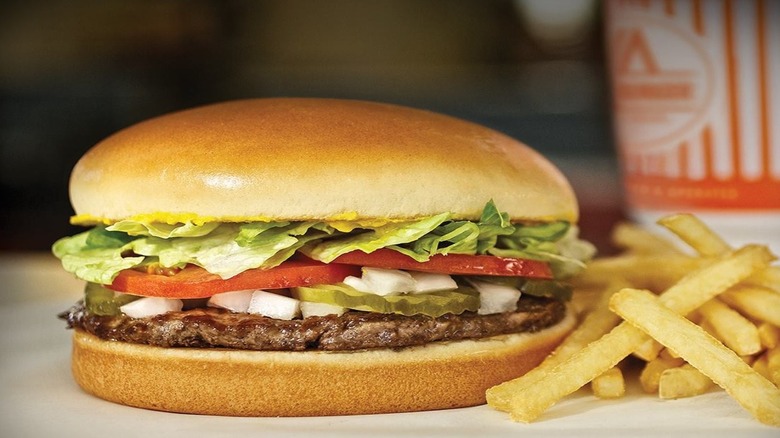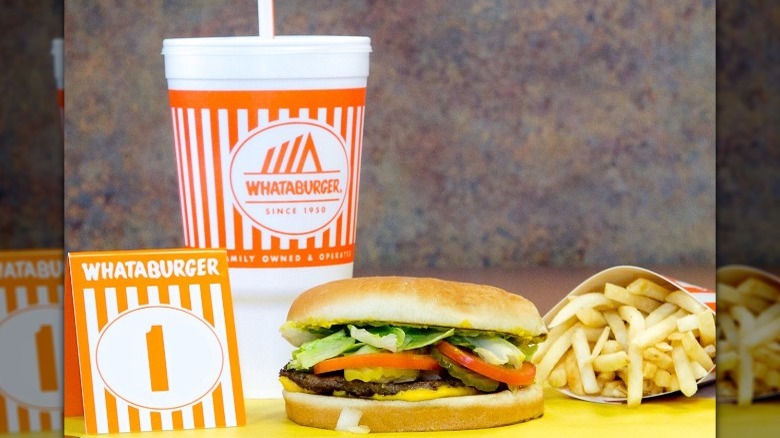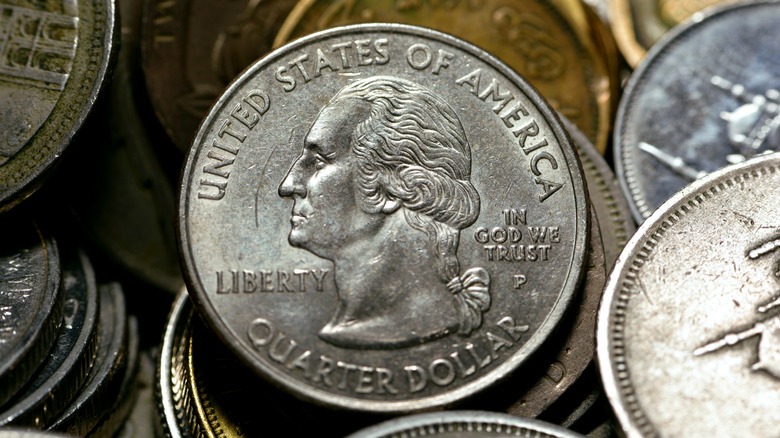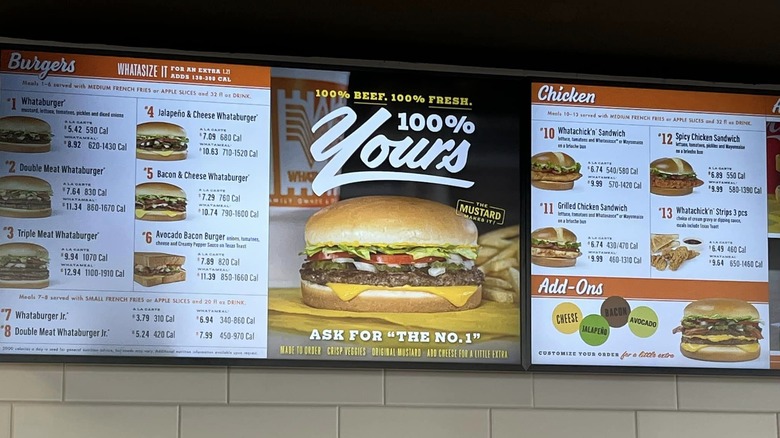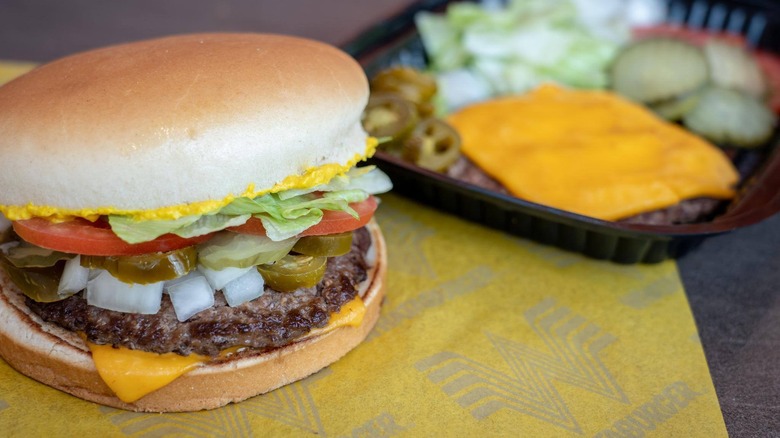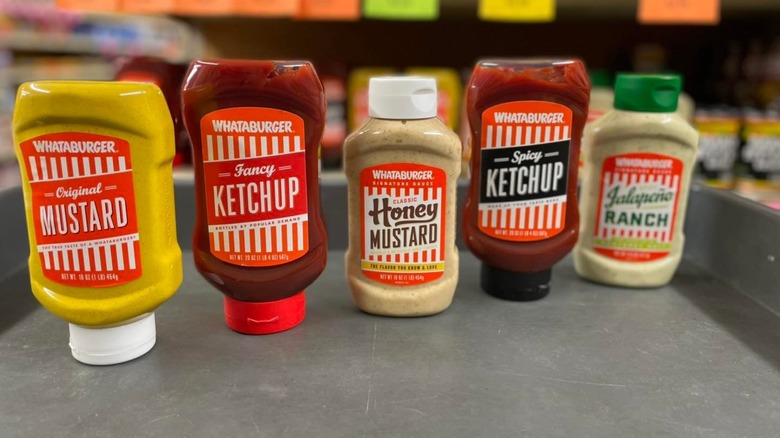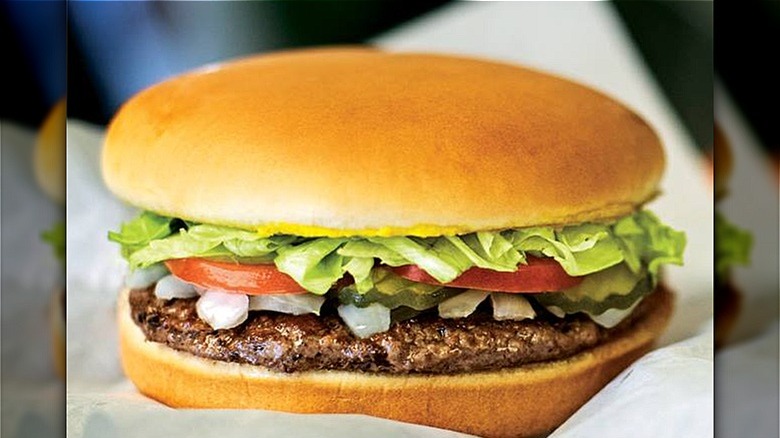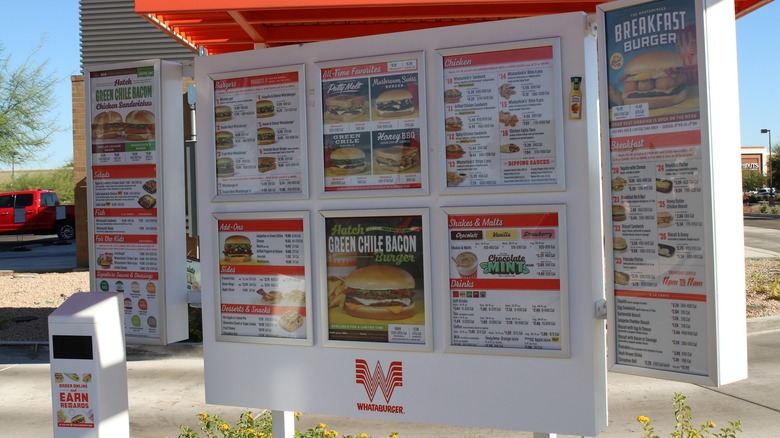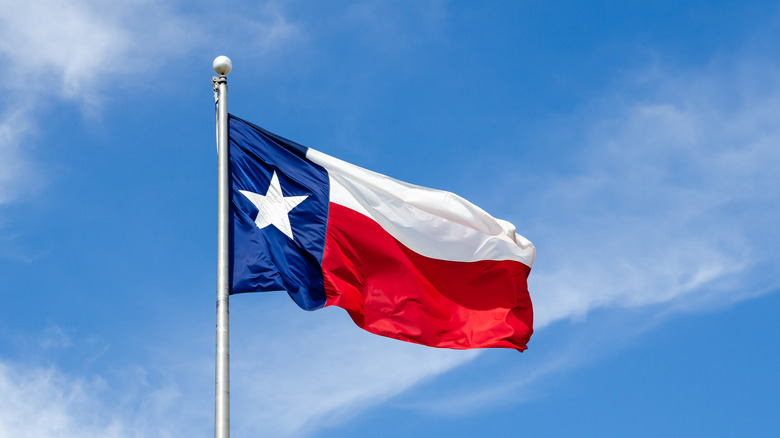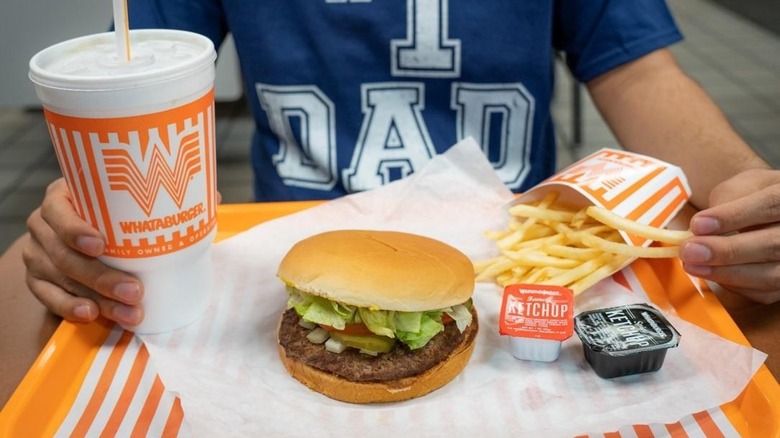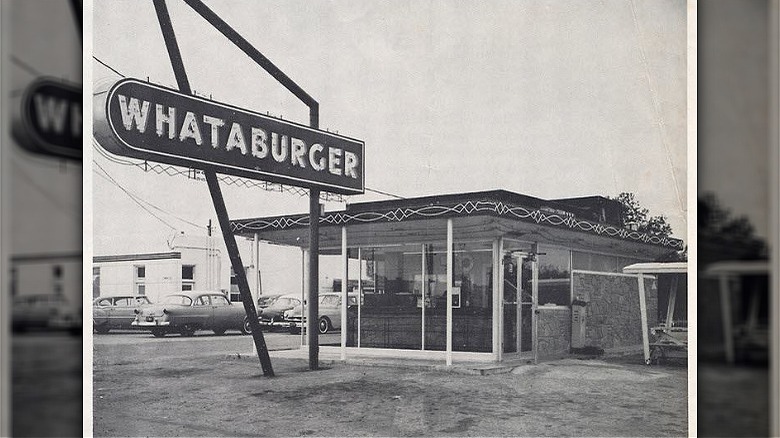The Truth About Whataburger's No. 1
From wide, pillowy buns to patties stacked to the heavens, the modern-day hamburger is a sight to behold. Yet none of this gluttonous excess would have been remotely possible without Texas-based franchise Whataburger and its flagship offering, the No. 1. Typically listed first on the menu, the No. 1 was the franchise's inaugural item that essentially set the stage for fast food decadence as we know it.
While other chains doled out comparatively tiny sandwiches and fries, this burger was different from the start, boasting a quarter pound of beef and a five-inch bread roll. Add on the five original toppers (lettuce, tomato, pickles, onions, and mustard) and there was no stopping the burger chain's climb, which currently tops 800 locations spanning the Southwestern United States (via Forbes).
Assuming you live near a Whataburger, you've probably eaten this hamburger more times than you can count. But as it turns out, being the chain's first offering isn't the only way the No. 1 became a fast food menu pioneer. Long before the chain claimed it could proffer 36,864 possible customizations, the No. 1 was a no-frills affair, a hearty hamburger that didn't skimp on the portions and promised customers a solid bargain in return. Over 70 years later, the impact of the No. 1 is still unfolding. Whether you're curious about this burger's Texan roots or its impressive size, you've come to the right place. It's never too late to find out the truth about Whataburger's No. 1.
The No. 1 is Whataburger's bestseller
Go beyond the No. 1 burger and you'll find that Whataburger's menu is bursting with variety. Think crisp salads and sandwiches grilled on giant slabs of Texas toast. But there's a good reason why hamburgers remain the joint's star attraction. After all, the chain began as a burger joint and continues to be a popular one thanks to the success of the No. 1. Along with the Patty Melt and Double Meat Whataburger, the flagship sandwich still tops the list for customer's go-to orders to this day (per Forbes).
Certainly, burgers in this day and age have progressed past the No. 1, both in size and complexity. Yet those facts don't diminish the downright ecstatic demand people have for this beloved sandwich. It's unpretentious and approachable, making it an easy pick for tourists and a no-brainer for born-and-bred Texans. It's not too big, not too small, and the combination of pickles and mustard adds a desirable kick to the leanness of the beef patty, as Business Insider writes.
Mountainous meat-addled sandwiches come and go in the world of drive-thru fare, but classic hamburgers like the No. 1 seem to never go out of style. And as Whataburger continues to experiment with brand-new combinations, the chain's signature only affirms its number-one status.
It cost a quarter in 1950
Not many things will cost a quarter these days, but when Whataburger first hit the scene in 1950, a No. 1 rang up to a measly 25 cents (via MySA). In 2022 dollars, that sum translates to $3.15 when funneled through the U.S. Bureau of Labor Statistics' Consumer Price Index Calculator. Surprisingly, when adjusted for inflation, the current amount is actually pretty close to what a Whataburger No. 1 costs today. As of this year, according to Fast Food Menu Prices, the sandwich on its own typically costs $3.09 or $5.59 when purchased with fries and a drink.
The burger might have been a steal back in the day, but as the Texas State Historical Association reveals, the low price came at the expense of profit. In response, the chain raises the price of the hamburger to 30 cents. The backlash was inevitable. In fact, the move provoked an irreconcilable rift between Whataburger co-founders Harmon Dobson and Paul Burton, to the point of ending the pair's business partnership for good the following year.
However, charging an extra five cents for the No. 1 did not force Whataburger into financial ruin. If anything, it helped the chain to thrive. Customers just really loved the hamburger, it turns out, and the high quality sandwich was worth every penny, no matter what price the chain listed (via Texas State Historical Association).
The No. 1 is made with fresh beef
Whataburger has always been ahead of the curve. On top of preceding McDonald's Quarter Pounder by about 20 years (via National Museum of American History the No. 1 also ushered in the trend of fresh, unfrozen beef (via Whataburger). As Whataburger's restaurant claims, each hamburger is cooked to order, with the beef never even looking at a heat lamp or freezer. A general manager confirmed this on Quora, stating that employees were forbidden from freezing meat to extend its shelf life. They also added that line cooks were free to use up any beef that was on the brink of expiring.
Although the image of a sizzling burger straight off the grill is an attractive one, recent reports suggest Whataburger's promises are somewhat misleading. In 2018, the U.S. Public Interest Research Group gave 21 major fast food chains, including Whataburger, an F for serving antibiotic-treated beef, as per the Houston Business Journal. Meat produced with antibiotics has been linked to the rise of drug-resistant "superbugs" that can make treating infections in humans more difficult.
Scientists have sounded the alarm on the dangers, as per Scientific American. The PRIG's Education Fund's Antibiotics Program Director Matt Wellington urged burger chains to reject the practice, saying "We simply cannot afford to lose life-saving medicines to produce a slightly cheaper burger" (via Houston Business Journal).
Whataburger's buns required custom equipment
Everyone knows that Whataburger's No. 1 changed the game with its colossal hamburger buns. Founder Harmon Dobson's mission statement, per Whataburger, was to craft the sort of hamburger requiring both hands, after all. Still, it's easy to forget the true extent of the brand's innovation. No other fast food restaurant was offering huge hamburgers like the No. 1 because, as Clio writes, the restaurant had to do it all itself. That included designing the equipment to bake the massive bread rolls that would become a signature feature of the burger.
Harmon Dobson and Rainbo Bakery owner G. M. Atkinson teamed up on the venture, according to the Texas State Historical Association. They did so in part due to the bakery's inability to produce the oversized buns. At this time, industry standards for burgers produced a puny finished product. Prior to Whataburger, a fast food burger featured just a two-ounce patty on a 2.5-inch bun, about the size of a modern-day slider (via Clio). What Dobson had in mind didn't exist yet, which meant that the fledgling business had to go it alone.
The resulting baking sheets included a total of eight molds to shape the buns, but production of the bakeware quickly amped up due to the restaurant's exploding popularity, according to the Texas State Historical Assocation. It turned out Harmon Dobson was on to something when it came to oversized hamburgers customers couldn't eat single-handedly — literally (via Whataburger).
You can buy the burger's mustard in stores
The single standard condiment that Whataburger squirts on a No. 1 won't be any sort of mysterious secret sauce or fancy spicy ketchup. Instead, all the No. 1 needs is a bit of classic yellow mustard. Specifically, that would be Whataburger's Original Mustard. For a while, the tangy zip of this condiment was reserved for paying customers inside the restaurant, but not anymore. As of 2013, Whataburger condiments are available for purchase in supermarkets across the Southwest.
QSR reported that the Original Mustard would be sold at regional stores in Mexico and Texas, including, as a Facebook post revealed, H-E-B, Central Market and Joe V's Smart Shops. Out of state customers can also buy the mustard at the online Whatastore. Here, fans can pick up three-packs of the Original Mustard for just $10.99, in addition to themed merch like clothing, drink tumblers, and even puzzles.
While we love a good branding moment, admittedly not all direct-to-store releases by restaurants are super authentic. There are two things that remain notable about Whataburger's bottled Original Mustard. One is how it's the exact same spread that graces a No. 1. More significantly, the recipe has not changed since the 1950s, according to QSR. In other words, ordering the sandwich or grabbing a bottle of the stuff will result in the same delicious taste Whataburger's has offered from the start.
Toppings are supplied by Freshway Foods
Crisp garnishes like lettuce, tomato, pickles, and chopped onions balance out a No. 1 hamburger. Should you stop to wonder where Whataburger obtains its ingredients, you'll find the source rests pretty far from Texas. Freshway Foods is an Ohio-based produce distributor that has counted the burger chain among its clients since 2020, according to the Sidney Daily News.
For a restaurant tied so closely to the Lone Star State, sourcing its veggies from the Midwest sounds like an odd move. But there's a method to the madness. CEO Ed Nelson has emphasized Whataburger's lack of local ingredients, and for that there's a simple explanation: quality control. He told the San Antonio Express-News that the upside of not relying on local produce results in a better burger all across the board. "We're across so many states and our volumes are so large, and our concern to protect our customers and to protect the great food that we supply is imperative to us," Nelson explained. "So we focus on sourcing for the brand and not individual, local suppliers."
Farm-to-table fare might be all the rage in the food industry, but at Whataburger, it's more about creating a consistent product time and time again.
The No. 1 isn't exactly healthy
The moment Whataburger's iconic A-frame silhouette comes into view, it's like all attempts at calorie counting fly out the window. Fast food burgers like the No. 1 might be irresistible, but we can't exactly claim that it's nourishing. If you peek at the Whataburger nutrition chart, you'll see that the burger contains 590 calories, 25 grams of fat, 62 grams of carbs, 12 grams of sugar, and 1,220 grams of sodium. Now, nobody expects diet food when hitting up a burger stop, but the levels of sodium are still quite high. It's even more eyebrow-raising when you learn that it isn't even the largest burger on the menu.
That said, you could pick a far worse option than the No. 1. Compare it to a Triple Meat Whataburger, for example. The Triple Meat Whataburger has the highest calorie count of all the chain's burger offerings, coming in at 1,070 calories, as well as harboring 63 grams of fat 130 milligrams of cholesterol, and 1,720 milligrams of sodium. Of course, we wouldn't expect anything less from a burger that's stacked with three patties (via Whataburger).
In theory, the No. 1 is tasty enough to warrant frequent visits. But for the sake of your health, we would advise you to treat this sandwich the way you would any artery-clogging delight: as an occasional indulgence.
Whataburger's No. 1 is uniquely Texan
Venture anywhere in the U.S.and you'll quickly realize how different hamburgers can be from state to state. Just look at Texas. Images of smoked meats and breakfast burritos typically come to mind, but the Lone Star State does burgers its own way, too. The state's take is commonly referred to as the Texas-style burger, which features onions, pickles, and mustard on a beef patty, as per Texas Highways.
Sound familiar? We basically described the main components of the No. 1. That's certainly no accident. According to Texas Monthly, Whataburger embodies the region's unique take on the sandwich. Mustard, for example, was once described as "a Texas tradition" by founder Harmon Dobson, and mom-and-pop diners active at the time seem to back this up.
What's more, the state even takes credit for inventing the hamburger. Per City of Athens, a Texan named Fletcher Davis allegedly introduced the sandwich in 1904 at the St. Louis World's Fair. However, as Texas Co-Op Power reports, the dish's origins have been widely contested by cities in Wisconsin, Connecticut, and New York, who assert true ownership over the dish. Disagreements aside, there's no denying the fact that Texas offers a distinct version of the fast food staple. Whataburger's No. 1 is clear proof of that.
It was hailed as America's favorite burger
There are over 80,000 burger joints in the United States today, as per IBISWorld. Considering that, Fast Company had a real whopper on its hands when it decided to poll Americans on their favorite fast food burgers in 2015. Covering 32 chains of varying size, the survey found that the best burger in America did not come from McDonald's or Burger King, nor from increasingly popular heavyweights like Five Guys or Shake Shack. The winner was none other than Whataburger and, by extension, the trusty No. 1.
According to Paper City, Whataburger's win is unsurprising given the competition. Most of the contenders were major chains. With a large number of them saturating domestic and international markets, it's unlikely that people felt particularly enthusiastic about them. On the other hand, Whataburger's reputation is more on par with In-N-Out; it's an exclusive regional chain with a much smaller footprint, which in Whataburger's case covers just 10 states, via Startland News.
The No. 1 hasn't exactly struggled to garner appreciation from Texans. Fellow foodies from MySA crowned Whataburger the top chain hamburger, also back in 2015. If anything, the national spotlight is a vindication of what Texans have known all along: that Whataburger's No. 1 is really number one.
Whataburger's No. 1 has never changed
It's safe to say Whataburger inspires a lot of die-hard devotion, but why? There's the sheer variety on the menu, for one, a fact that draws abundant foot traffic on a literal 24-7 basis for some locations, according to Eater. And while customers might be tantalized by the more novel offerings (breakfast taquitos, anyone?) it's the classics that fans find themselves coming back to again and again. This appears to be the case for the No. 1, a burger that has, by all accounts, never changed.
Yes, you heard that right. Much like its mustard, Whataburger's prized sandwich has essentially stayed the same since the mid-20th century. Sure, maybe the machinery or specific suppliers have shifted here and there, but the essence of this menu mainstay has not. Texas Monthly can vouch for us here, reporting that the flagship burger continues to be assembled as it was in founder Harmon Dobson's time. It still features the same 5-inch buns, the same freshly-grilled beef patties, and the signature slew of toppings folded inside.
Seeing old favorites hang on speaks volumes. For those of us who grew up eating Whataburger, it's a reminder that the No. 1 is always ready to please diners in just the same way, whether it's 1950 or 2050.
